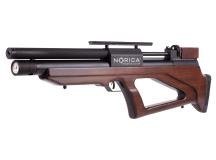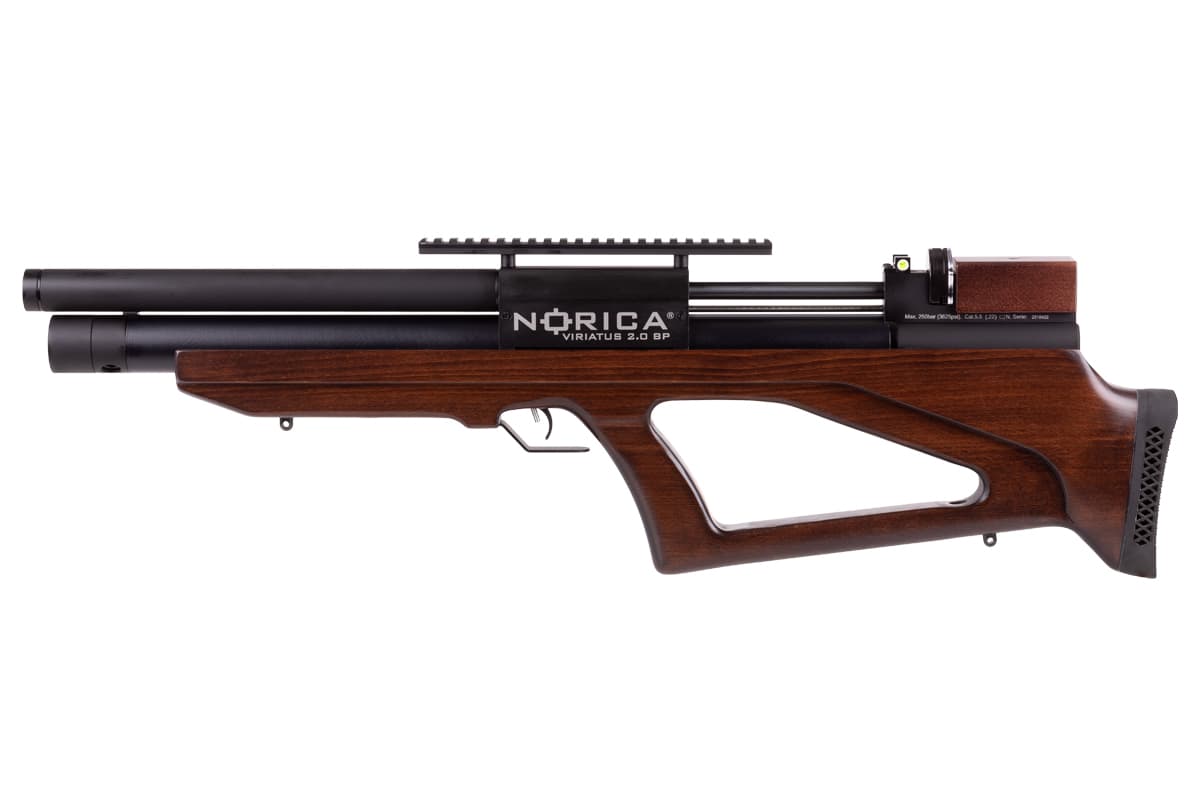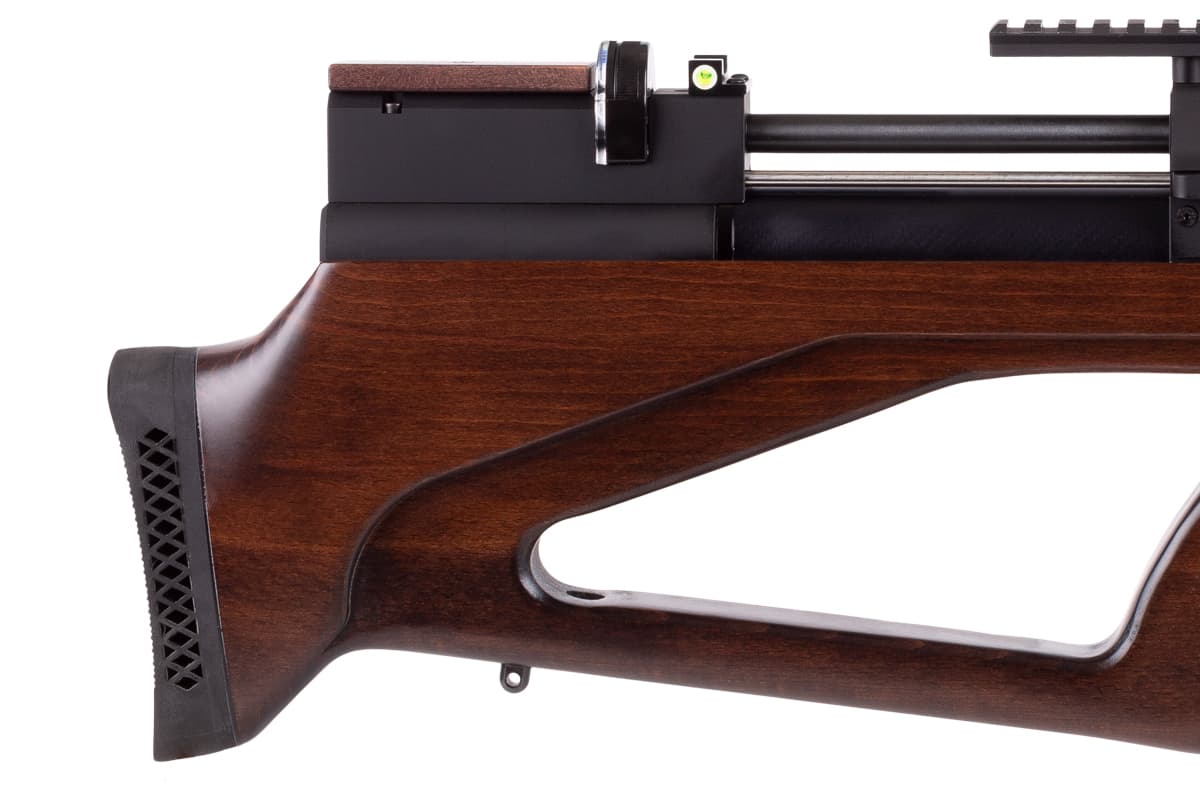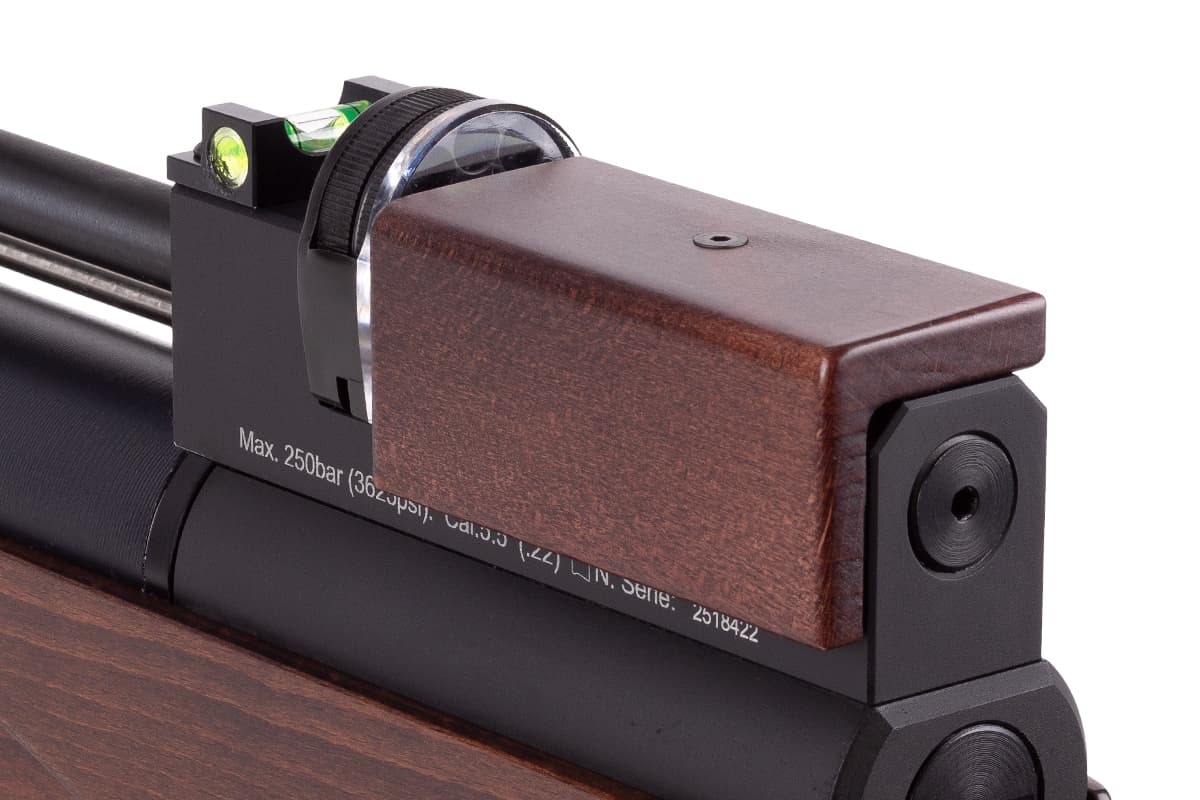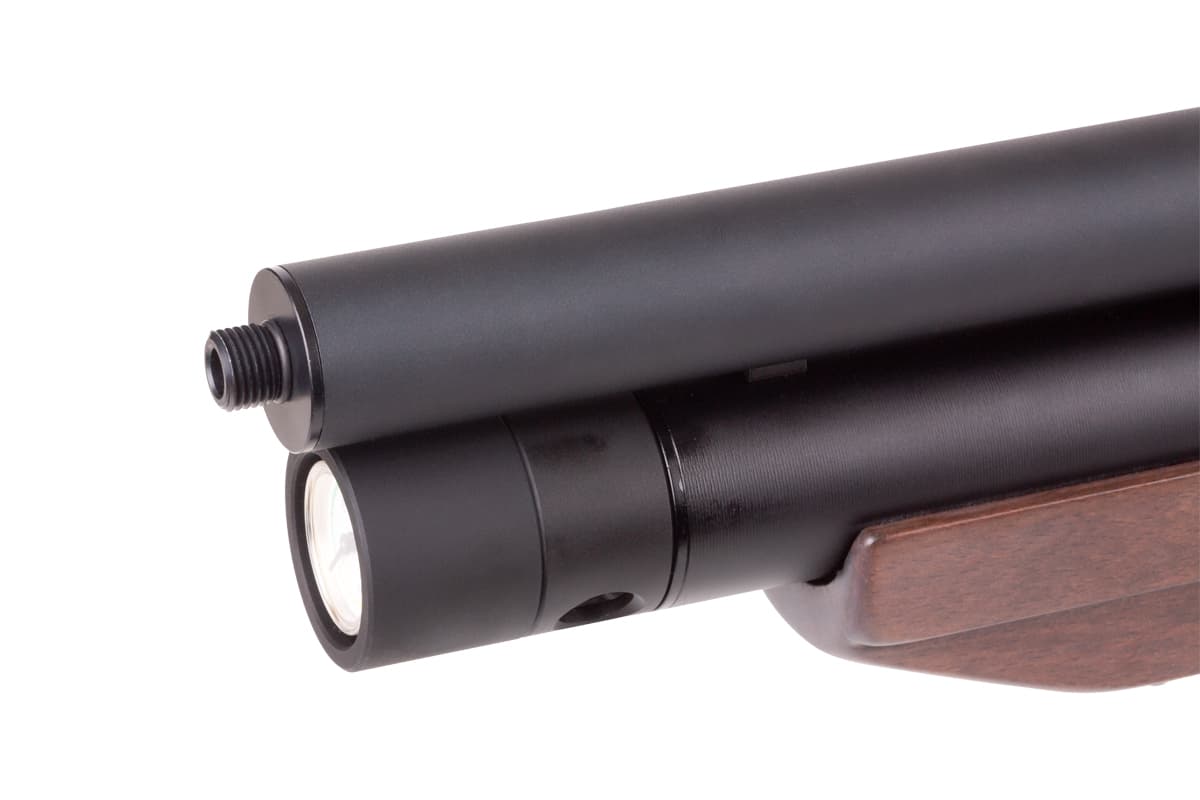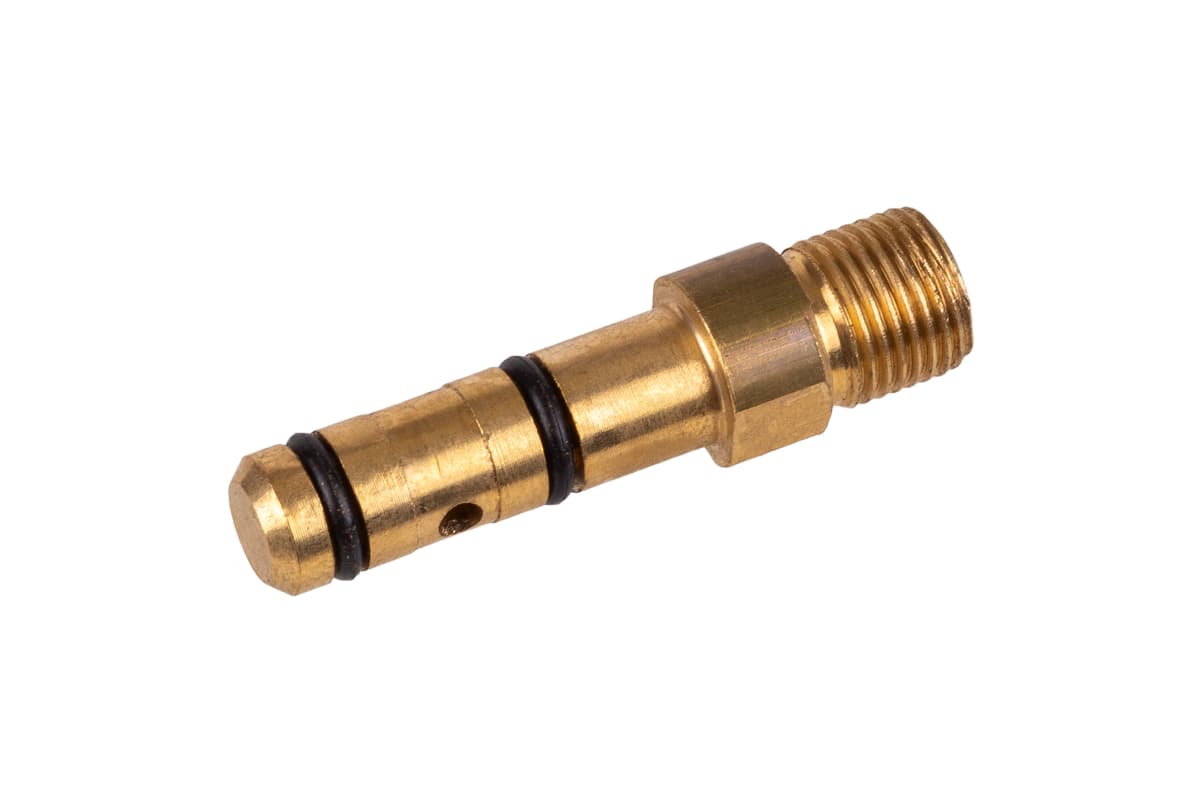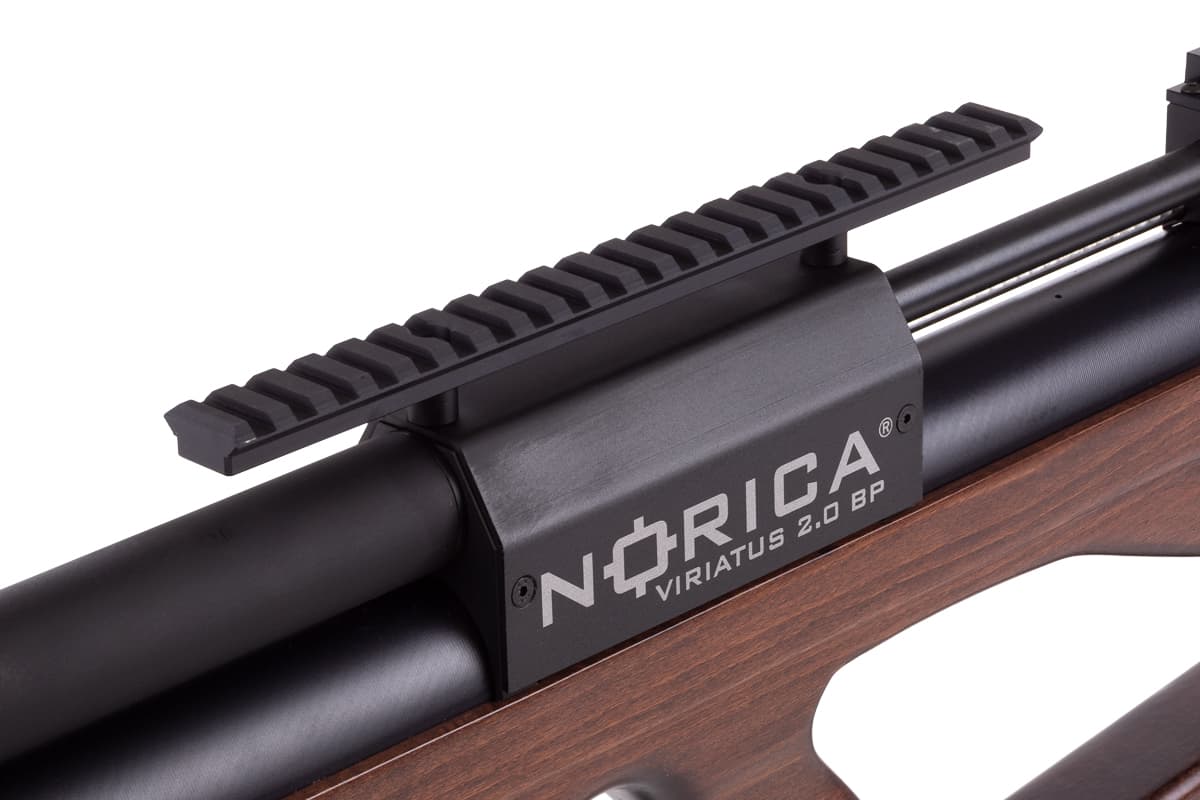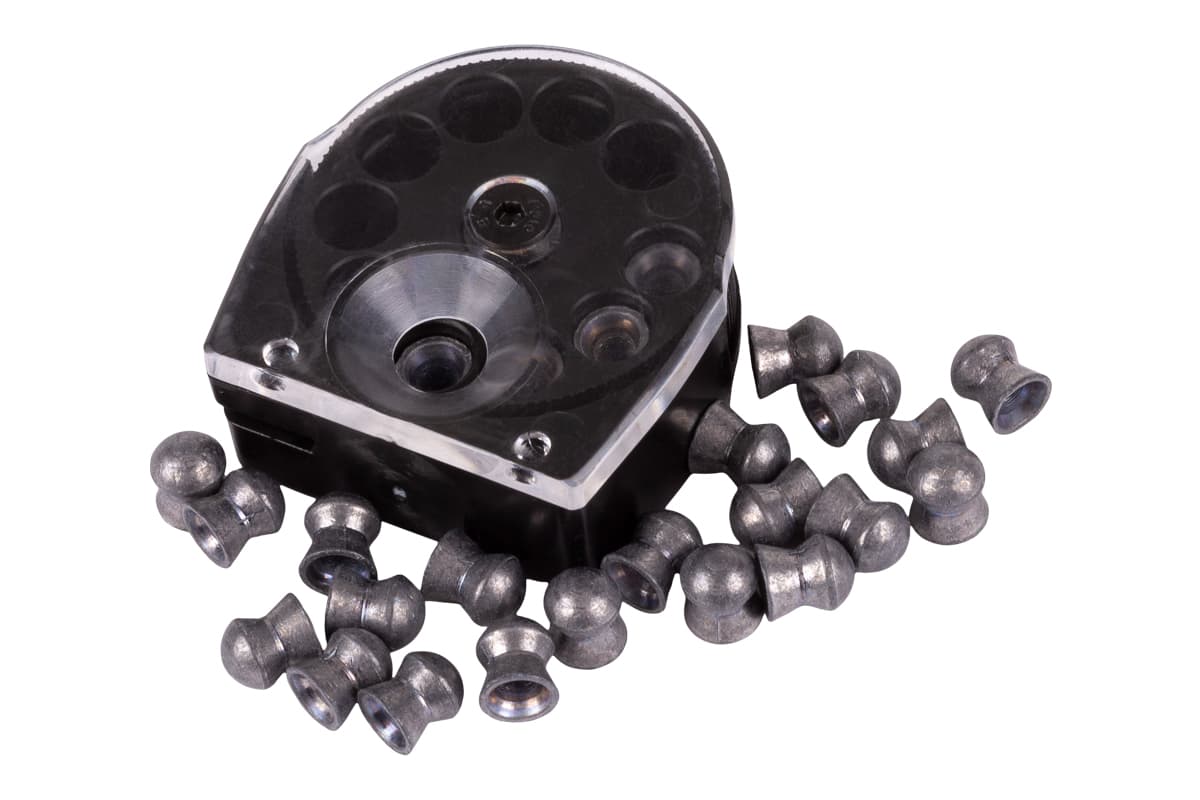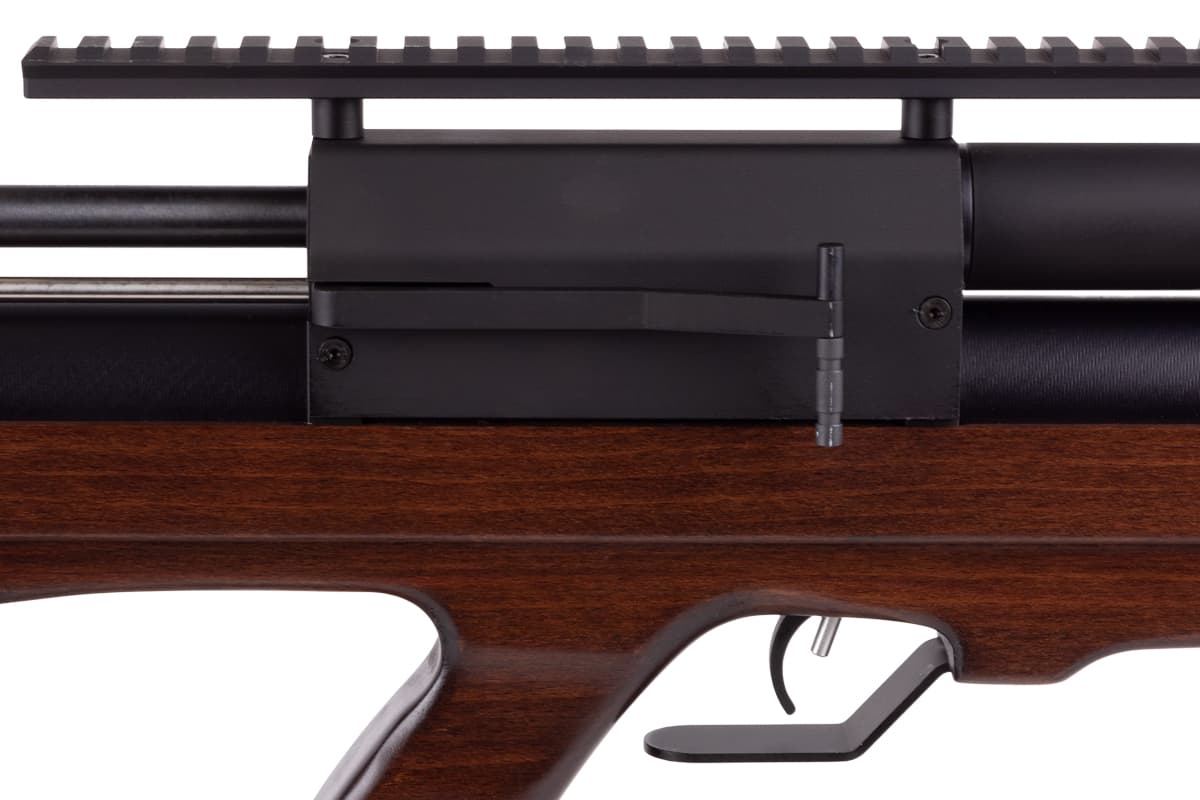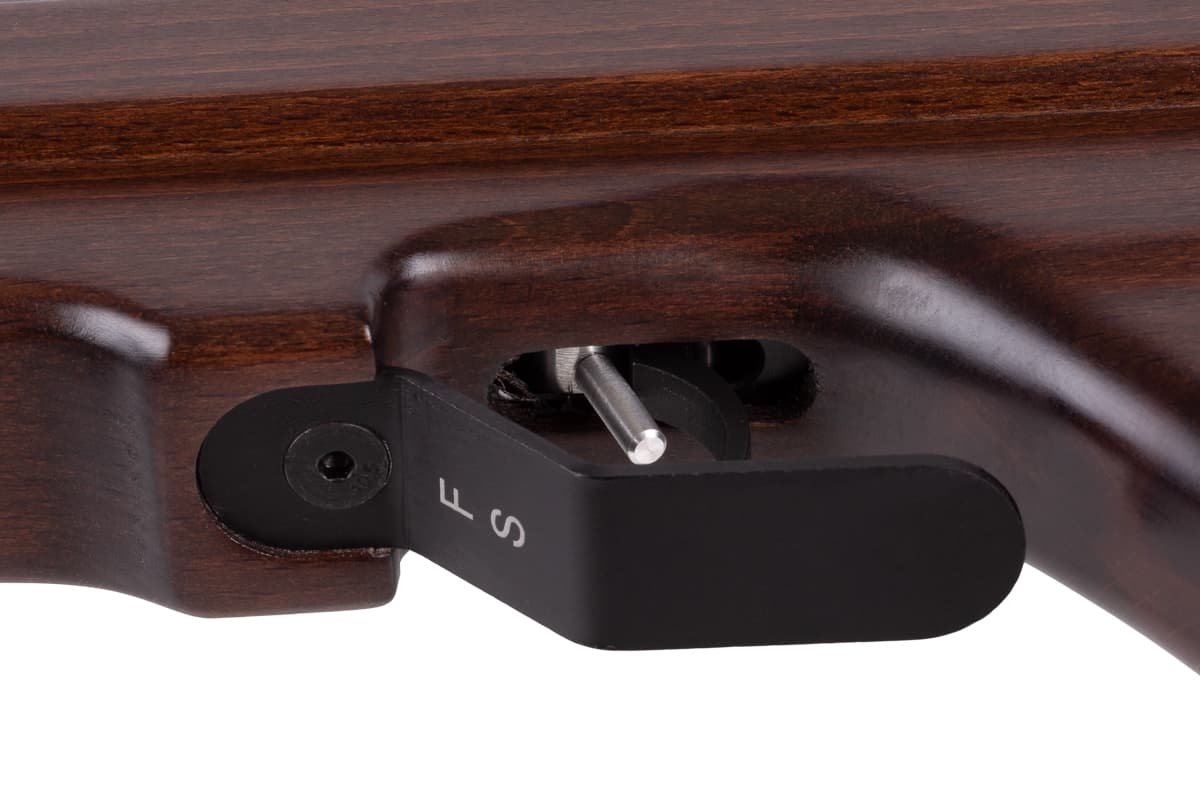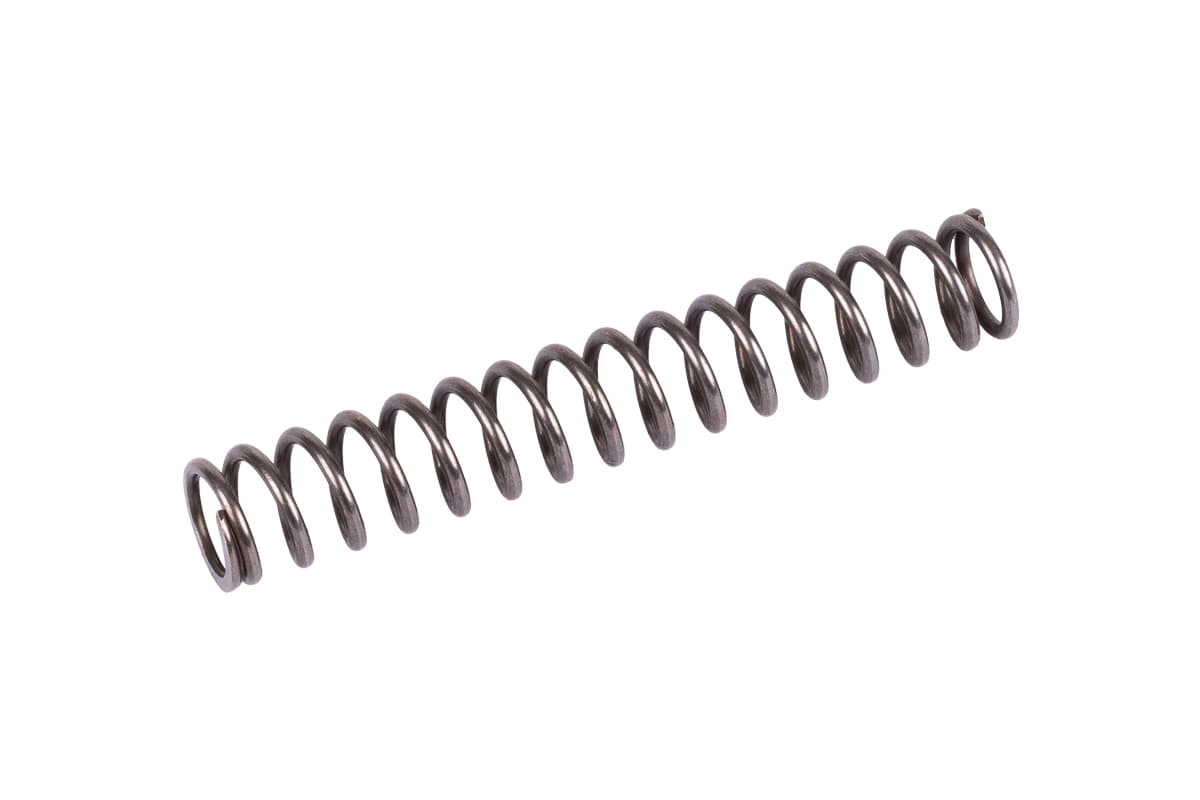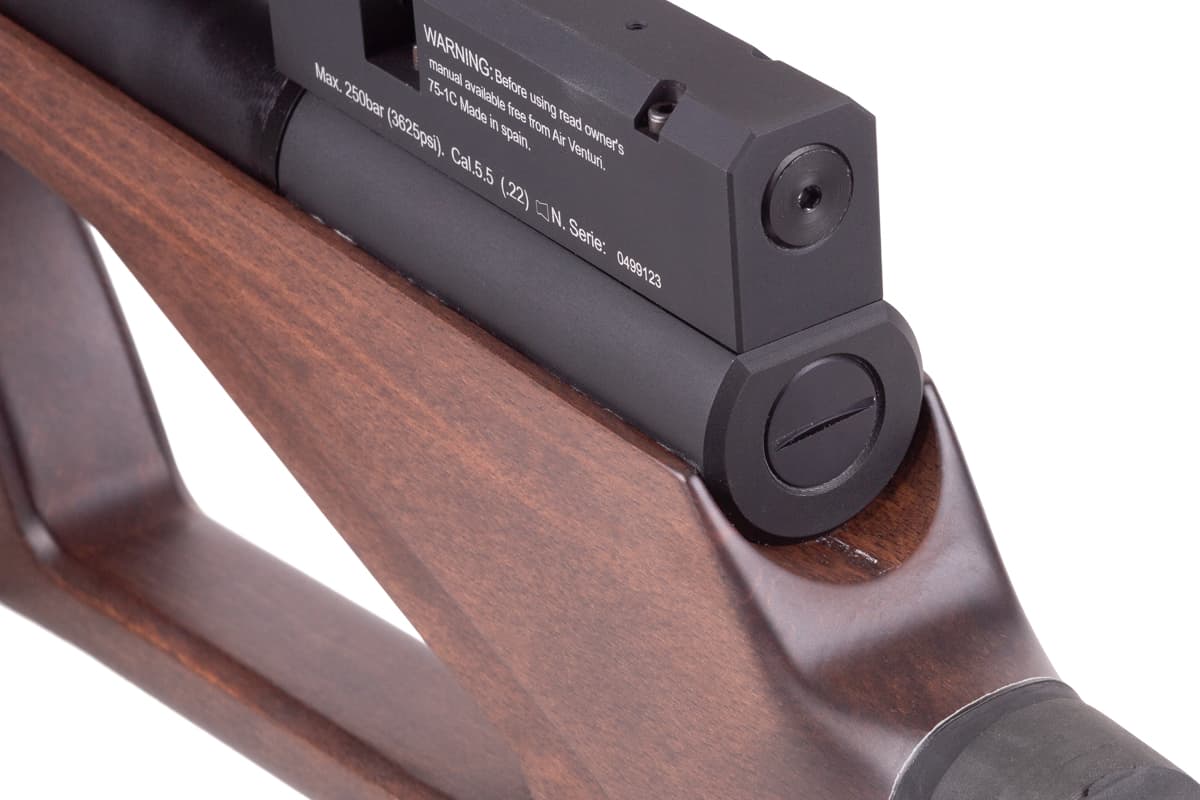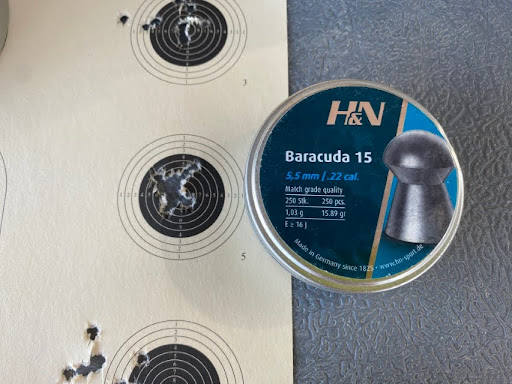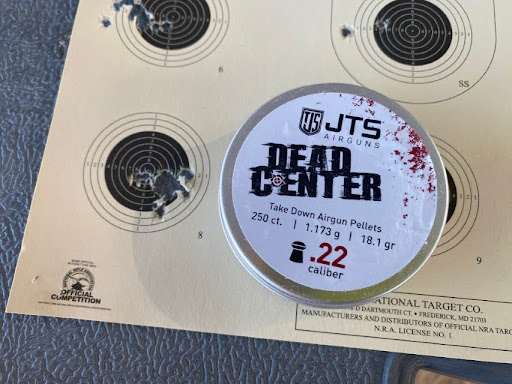Definitive Guide to Norica Viriatus
The Viriatus 2.0 BP (we are guessing the BP stands for "bullpup") is a compact, regulated PCP airgun. It features a beautiful ambidextrous wood stock and metal construction. It is available in .177, .22, and .25 calibers. Our sample is chambered in .22. It delivers exceptional performance with minimal noise impact on your suburban environment. This regulated PCP air gun offers an impressive 70 consistent shots per fill, making it perfect for extended shooting sessions without disturbing the neighbors.
The rear of the stock is equipped with a rubber buttpad, ensuring a comfortable shooting experience from the minimal felt recoil. Further, the rear swivel stud, matching the front swivel stud under the forearm, is ideal for long hunting outings and fieldwork. This feature is sure to be appreciated by outdoor enthusiasts.
On top of the receiver is a small wooden cheekpiece. While this may not seem that important, it adds to the overall comfort during shooting. Rather than resting your cheek on a cold or hot, given the time of year, black metal receiver, you have a far more comfortable cheek weld.
The .22 caliber 10-shot, auto-indexing magazine, 12-shot in .177, or 8-shot in .25, sits forward of the wooden cheek rest. Just in front of the magazine is the integrated bubble level. This is very useful and helps shooters maintain proper alignment with their optic and shooting position.
The Viriatus comes with a match-grade Lother Walther barrel that is partially shrouded. At the end of the shroud is a 1/2 UNF threaded end cap for accessories. On top of the receiver is the 8.85" Picatinny scope rail. We like the added length, which provides more flexibility when it comes to picking your optic.
The whole package weighs in at about 6.39 pounds, which is relatively lightweight for a modern airgun. There's a manual safety in front of the two-stage trigger. It's adjustable for pull weight and 2nd stage travel. Be sure to review the manual because it can be over-adjusted, causing the rifle to either not cock properly or not have enough seer engagement. The latter issue could be very dangerous, leading to an accidental discharge. Please seek professional assistance if you are going to adjust the trigger.
Setup & Operation
As this is a PCP airgun, you will need to fill it before use. The 340cc air cylinder can take a max fill pressure of 250 bar or 3620 PSI. The cylinder is filled via a fill probe that requires a fitting if you want to use it with a standard quick disconnect setup. Be sure to add the Air Venturi Male Quick-Disconnect, 1/8" BSPP Female ThreadsAir Venturi Male Quick-Disconnect, 1/8" BSPP Female Threads fitting to your order, or you may not be able to fill your gun.
The factory regulator is set to about 110 bar, so anything over 1550 psi will be regulated. We'll get to shot count and power later, but let's just say that the Viriatus does very well on both fronts. Running at maximum power, this airgun delivers approximately 30 foot-pounds of energy - plenty for pest control and target shooting.
You'll also need to mount some sort of optic or sight. Bullpups are generally a challenge to shoot because of their ergonomics. If you look at a normal rifle, the cheekpiece is usually lower than the barrel, allowing optics to be mounted close to the bore. This is better in many ways, specifically for long-range shooting with minimal arc. Bullpups generally have the cheek weld in line with the bore, which is enough of a challenge, but the Viriatus is set up with the cheekpiece above the bore. If you are going to mount a scope, you will need very high mounts in order to achieve a comfortable shooting position. Another option would be to use a riser rail, which would give you more flexible mounting options. Once you've filled your rifle and mounted your scope, it's time to get ready to do some shooting.
To get started, you'll need to fill the 10-shot magazine. It's a very simple, spring-loaded design. Simply drop a pellet in the hole and rotate the magazine to the next hole, holding it in place until you drop in the next pellet. Continue the process until the magazine is full.
Cock the rifle using the forward-mounted side lever and load your magazine. The position of the side lever is very comfortable and easy to operate. It's better than other bullpups, where the side lever is back behind the mag and right next to your face.
When you are ready to fire, release the safety and gently squeeze the trigger. Our trigger felt OK. The pull through the 2nd stage was a little rough but relatively light. It's a sub-2-pound trigger. The length of the 2nd stage can be shortened, but as mentioned above, do so with extreme caution.
To fire again, simply work the side lever backward and then forward, and you'll be ready to take your next shot. It's a pretty comfortable and enjoyable shooting process.
One small point of note: there is a noticeable ping when firing. In our opinion, the mechanical ping is louder than the shot noise, probably because the hammer is right at your ear. This certainly made the sound even more noticeable than it would be in a more traditional rifle.
Performance & Accuracy
The Viriatus ships with two hammer springs. There is a light spring and a heavy spring. Our model had the light spring installed from the factory. Using 18.13-grain pellets for our velocity and power testing, the light spring delivered just under 400 FPS at the low end and up to about 650 on the high end. The heavy spring started around 630ish and topped out at around 900 FPS. The light spring took about 7 turns to go from the high 300s to the mid 600s. The heavy spring needed about 2 turns to see maximum velocity. Each unit may be slightly different, so if you want to truly dial in your airgun, be sure that you have an accurate chrony on hand. We ran all our tests on max power.
The shot count was nothing short of amazing. We easily got 70 shots per charge before dropping off the reg. Moreover, the extreme spread across all 70 shots was around 26 FPS. Testing conditions haven't been great, but we managed to find a window where the winds weren't too terrible and at least in the single digits most of the time. Being a new brand to us, we didn't want to simply assume that the JSB 18.13-grain pellets would be the "go-to" for this rifle. They often are the most accurate, but we wanted to take a broader look at performance and accuracy given the newness of the product. We set up our target at 40 yards and got to work shooting several pellets.
Here's our list of pellets with their average velocity and energy:
As you can see from that chart, our model is a 30 FPE airgun at full power, with heavier pellets giving us more energy on target than lighter pellets.
Now, when it comes to accuracy, the Norica Viriatus air rifle certainly had its favorites. While most of our .22 airguns in this power range really love the JSB 18.13, the Viriatus seemed to prefer 15.89-grain H&N Baracudas, followed closely by the 18.1-grain JTS Dead Centers. Let's take a look.
10 Shots at 40 Yards - H&N Baracuda 15, 15.89 Grain, 915 FPS, 29.55 FPE
10 Shots at 40 Yards - JTS Dead Center, 18.10 grain, 882 FPS, 31.27 FPE
Summing Up
Pro Tips
- Consider adding a riser rail for more flexible scope mounting options
- Have a chronograph on hand for precise power adjustment
- Maintain proper trigger adjustment for safety
- Keep the included manual handy for reference
The Viriatus 2.0 BP represents an excellent value for the serious airgun enthusiast who demands reliability, accuracy, and versatility in a suburban-friendly package.
